[UPDATE] CEB Stock Review: Is Cebu Pacific Air An Attractive Buy Today?
I was inclined to take a look at Cebu Pacific Air (CEB) again because of COL’s earnings analysis. According to the report, core income rose to 25.5% y/y to P7.0B.
Truly Rich Club recommended to buy again the stock during the last week of July. I think every investor out there is now bullish on CEB.
Last year, I made a valuation about this company (here). I realized that the data I presented back then isn’t complete and only focused on a few details and neglected some important points. In this post, I’ll try to dig deeper into its annual reports one by one so that I can give a more detailed insight.
So let’s begin!
Valuations
CEB is trading at P120.10 per share as of this writing. With 605.953M shares outstanding and with net earnings of P4.387B last year, this puts the company at a P/E ratio of 16.59 which places the business at an attractive valuation.
In 2015, revenues totaled to P56.501B which translates to a net margin of 7.76%. But in 2014, CEB only manage to make P853.498M in net earnings versus revenues of P52B. This gives us a net margin of 1.64%.
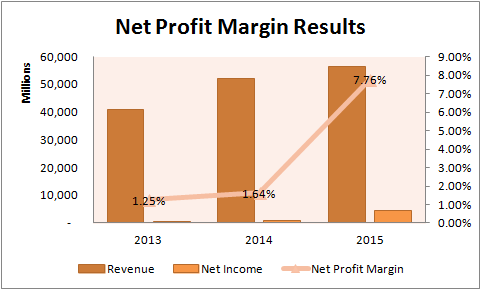
Fig. 1 Net Profit Margin
From 1.64%, the margins jumped to 7.76% in just a period of 1-year. That’s an astonishing 373% growth! Now how did that happened?
It seems that CEB has managed to lower their expenses at the same time increase their revenues. Revenue grew by 8.7% from 2014 to 2015 while expenses declined by 2.2%.
Earnings And Book Value
Earnings per share grew by 68% in 2014 and 413% in 2015. Book value grew by 2% in 2014 and 16% in 2015.
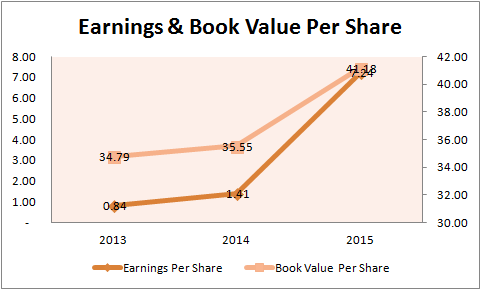
Fig. 2 Earnings & Book Value Per Share
Analyzing Returns: ROE, ROA And ROIC
Let’s compare the returns relative to the company’s equity.
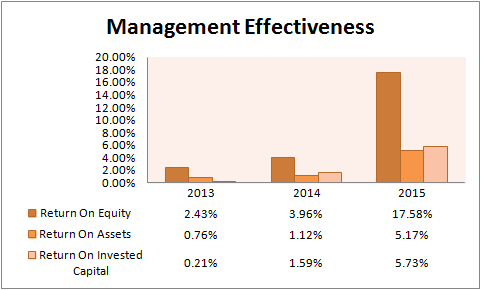
Fig. 3 Management Effectiveness
Return on Equity grew by 344% from 2014 to 2015 and this increase is because of higher earnings as per DuPont Analysis. If you’ll notice, the Return on Invested Capital is low mainly because of high debts. This suggests that CEB has a weak moat. This also suggests that investor capital isn’t being turned into profits efficiently.
Normally, we want RoIC to be almost equal to its RoE or at least 12% to 15%. 20% would be ideal. But that’s not the case with CEB.
Non-operating/Non-recurring Losses
CEB accumulated huge hedging and forex exchange losses amounting to P2.931B and P2.205B in 2015. The hedging losses are the results of lower market-to-market valuations on fuel hedging positions. The forex losses are the result of Peso depreciation. CEB is highly exposed to forex fluctuations because the company incurred U.S. dollar denominated rates in connection with aircraft acquisitions.
Long-term Debt
CEB acquired four airbus A320 aircraft in 2015 and five airbus A320 aircraft in 2014. This resulted to interest expenses amounting to P1.073B and P1.013B respectively. But since operating profits increased from 72.90% in 2014 and 133% in 2015, the interest expense margins declined.

Fig. 4 Interest Expense Margin
Although this is the case, this placed the company at a risky position. The current ratio worsened since huge amounts of debt was used to fund expansion. Same is true with the D/E ratio.
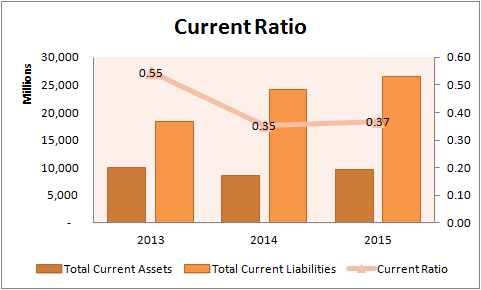
Fig. 5 Current Ratio
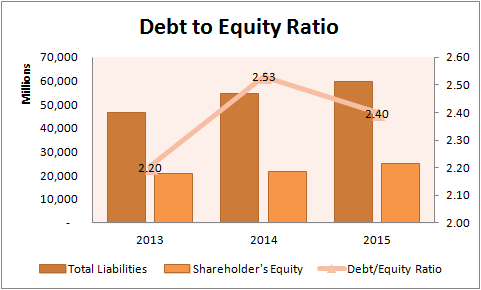
Fig. 6 D/E Ratio
Anywhere you look at it, CEB really has too much debt to handle. Total short-term debts are greater than the company’s cash.
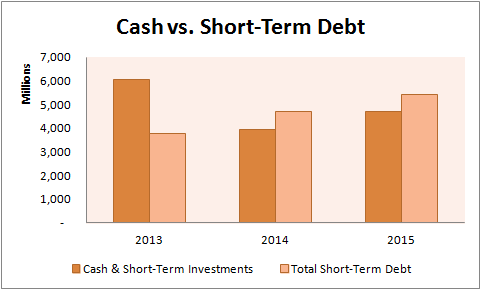
Fig. 7 Cash vs. Short-Term Debt
Total debts are also greater than what the company is retaining every year.

Fig. 8 Retained Earnings vs. Total Debt
Just imagine how much risk there is.
Cash Flow Statement
At least with the cash flow statement, we can see that even though they have negative FCF for the past 3 years, it’s improving. If this will continue, maybe we can expect positive FCF this year or the next.
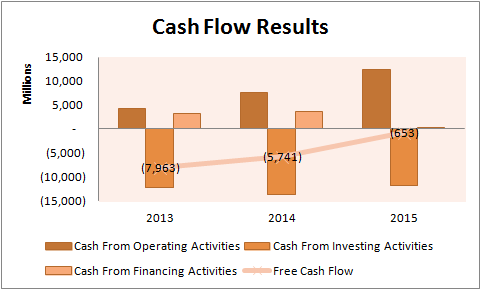
Fig. 9 Cash Flow Results
Capital expenditures averaged at P12.847B for the past 3 years while operating cash flow averaged at P8.062B. Based on these assumptions, CEB should improve their operating cash flows so that they can pay of their debts and minimize availment of future loans.
Is Cebu Pacific Air (CEB) A Good Buy?
At a P/E of 16.59, buying at P120.10 per share will only yield a 6% return in one year based on this assumption. But a company that grew profits by 757% in a 3-yr period is something you should consider when making a buy decision. Also consider the company’s weak moat, huge amount of debt and the risks involved in acquiring those liabilities.
Final Thoughts
Cebu Pacific Air has improved their earnings last 2015 and based on this year’s 2nd quarter results, CEB is doing good. If this will continue, we would expect healthy cash flows in the next couple of years.
What I don’t like is that the nature of their business requires huge amounts of capital expenditures and expansion is mostly done by acquiring huge amounts of debt. This puts the company’s financial health in a huge amount of risk. if cash flows will improve, they should prioritize debt payments so that their interest rate and forex exchange risks could be lessened.
At today’s price, CEB is a good buy but there’s just so much risk that the company is managing. And that’s something that gives me second thoughts.
This concludes my updated CEB stock review. So do you think that CEB is a good buy today considering all the points I mentioned above? I want to hear what you think. Share your thoughts below.
Happy investing!
